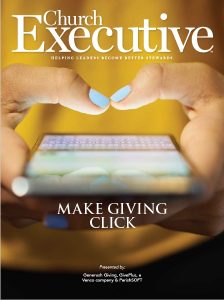
Expert advice for using technology to identify, engage & cultivate first-time givers

Former Pastor & Chief Operating Officer
Generush Giving
What does a first-time giver look like?
Mark Walker: We shouldn’t base our assumption on whether people are young or new in the pew; first-time givers look different, in different churches.
As leaders, we should have our finger on the pulse of our churches. We need to know who’s new, who serves, and who doesn’t. Who gives and who doesn’t.
Additionally, this information shouldn’t exist only in one person’s head. There must be a system in place to detect and celebrate first-time givers. A digital giving and donor management system gives us the tools to be in the know, follow up with and engage them.
Jennifer Buckley: First-time givers vary depending on the makeup of your church or parish. Sometimes, they’re the new faces you see in the pews — but often, first-time givers are members or parishioners who either haven’t been able to give in the past or aren’t aware of the different giving options and needs at your organization. Most churches have a small percentage of their regular attendees who give regularly (usually about 10% to 25%), but that small percentage makes up more than half of the total donations.
So, if you want to know what a first-time giver looks like, look at all the faces in the pews during mass, not just the new ones.

eGiving Ambassador
GivePlus, a Vanco company
Richard Bauer: There is no “typical” first-time giver.
It’s easy to think that only young members and new members are first-time givers, but the fact is, many people attend their church for a considerable amount of time before making a gift.
This is why technology is so important when it comes to improving giving at your church. Using church management systems and eGiving tools, you can track who gives, how they give, and when they give.
It also can tell you which members you should approach about making a first gift.
When a church leader considers ways to engage first-time givers, technology probably isn’t the first thought. But why should tech spring to mind in this instance?
Buckley: Historically, the Church has survived through physical donations from parishioners who attend regularly. The introduction of technology over the decades has changed the way people manage their work time, personal time, and spend their money.
Imagine a small town where one main road is used to get everyone to where they need to go. As more people move in, you need more roads to accomplish the same task. That’s what has happened to giving.

Giving Specialist
ParishSOFT
Only 21% of Americans carry checkbooks anymore, and only 41% carry cash. (And even then, it’s usually in amounts less than $20.) Now, 49% of all donations to churches and parishes are made by credit card.
Plus, churches that accept tithing online increase overall donations by more than 32%.
Bauer: Removing barriers to giving is critical when approaching first-time givers, and technology does that. eGiving technology is a great way to open the conversation about giving.
Approach new givers by showing them how easy technology makes giving. Offer to show them what eGiving tools you have, send them a link to your giving webpage, or demonstrate making a gift. Make it easy to give the first time, and they won’t think twice about giving in the future.
We have seen in many churches that first-time givers start with a small gift. But once they have an account set up, they start giving larger and larger amounts. It’s amazing how a small initial donation can blossom into sustained, substantial gifts.
Walker: Whereas many church leaders don’t think of themselves or their churches as “tech-savvy,” they do want to think of themselves as relevant. In today’s society, relevance will require us to lean into technology at some point. A forward-thinking church looks for new ways to be relevant to its community and engage more people with the message of Christ.
As such, technology should be foremost in our thinking. Consider how we already use technology to better our services, coordinate with our congregations, reach outside the church walls with social media, and more. Why should providing a digitally based giving solution be any different?
Plus, harnessing technology to engage first-time givers has a high return on investment.
How can technology be used to identify potential first-time givers in the church?

Bauer: Many of our clients use church management systems (ChMS) that can help. But, sometimes the data doesn’t come from technology — you can eyeball it. If someone returns again and again, they clearly like what they’re getting. That’s an opportunity to discuss a first gift.
ChMS can help spot potential givers even if you don’t have financial data in it. Take a look at their activities. Do they come to church regularly? Do they participate in groups or join dinners? Active members sometimes don’t give because they are adding to the church community in other ways. Identify these active non-giving members and begin a discussion about making that first gift.
Finally, look to national trends regarding cellphone use and payment preferences. Studies show around 95% of Americans own a cellphone, and the use of checks and cash is diving fast. Churches shouldn’t ignore this data.
Walker: To identify first-time givers, we first need to know who’s already a giver by looking at our current giving data. Yet, in our experience, many pastors and leaders don’t have access to this information.
Becoming a giver is a significant indication of one’s spiritual journey. Just as we wouldn’t withhold a new faith decision or marital trouble from leadership, neither should giving data be withheld. With access to this information, leaders can make insightful decisions to identify and engage with potential first-time givers.
Other technologies the church uses can help provide the reference data to indicate first-time givers. New child check-in could indicate a new family who has recently begun to attend. Seeing new “likes” and shares of our social media and live stream posts can also indicate someone newly engaged with our church and positioned to make giving their next step.
Buckley: When identifying first-time givers, one thing that most church leaders look at is volunteers or ministers. Among donors, 66% have volunteered within the last six months, with 85% of that group volunteering for the same non-profit organization where they donated. Often, people who are generous with their time are also generous with their talent and treasure.
Consider how you can reach out to members who regularly offer their time for children’s church or child care, or those who volunteer to be chaperones on youth trips and events. This is an excellent segment to start with if you need to identify potential first-time givers at your church or parish.
Once potential first-time givers are identified, how can technology come alongside the church to cultivate them? And related to this, are e-communications appropriate for cultivating first-time gifts?
Walker: When people know their giving makes a difference, they become energized. The fastest and easiest way to deliver feedback is leveraging technology and e-communications.
Whether email or social media, letting givers and potential givers know what a difference their giving is making puts the “why” back in the forefront. When we start and end with the why, the “what” (the act of giving) becomes less of the focus.
If emailing a first-time giver about his or her first gift seems awkward or inappropriate, emphasizing the difference their gift makes in the church, in the community, and in their own lives, lets that giver know we want something for them, not something from them.
Buckley: Online giving makes it very easy for people of all generations to give, even when they’re not at a church service or mass. Plus, 55% of donations to a church are made between Monday and Saturday.
These days, people expect a certain level of electronic communication. Email messaging accounted for 26% of all online revenue in 2018, and 21% of those donations were made directly through social media.
Plus, mobile donations have increased 205% over the last year! This isn’t surprising, since 57% of all internet traffic is accounted for by mobile devices alone.
Additionally, you must make giving of time, talent and treasure part of the culture. Put up posters in gathering spaces; have handouts available; host events centered around it, or with a giving option tied to the event; and help make it easy to give.
Bauer: Just as people give the way they’re comfortable giving, they have preferences for communicating. Most of us use technology to communicate every day. Churches should keep that in mind. If a member’s go-to method for chatting with friends and family is text messages, why wouldn’t the church engage them through text?
You can also use technology to tell your church’s story and talk about giving. Make a video, share ministry work on social media. Use technology to fill in the knowledge gaps about your mission to motivate first-time giving.
I recommend not approaching a first-time gift as a heavy thing draped in ritual and propriety. For some leaders, the habit of reaching members using traditional methods is holding them back. The time and expense of sending appeals on church stationary through the mail isn’t always necessary. There’s nothing wrong with conversing with members in their favorite way. Successful churches today use technology to reach their members, because that’s how members want to reached.
Can technology be useful in the logistics of collecting / receiving first-time gifts — and even setting up people to become more regular givers?
Buckley: Yes; with online giving software, donations don’t have to be counted or deposited in your bank, because most giving platforms do that themselves.
Our own web-based Family Suite software has an option for either bulk import of contribution data, or automated data import, offering a way to get it into your ChMS easily.
Most ChMS solutions offer a series of reports and statements that can be sent to donors to show them where they are in their giving at any time. This encourages them to give more, because most people have a goal they try to meet, on a personal level, before the end of the year.
Recurring givers annually donate 42% more than one-time givers, so offering givers the ability to set up recurring gifts at weekly or monthly intervals will encourage them to give more consistently.
Bauer: With eGiving tools, the journey from being a first-time giver to a regular giver is easier than it has ever been. Once you get a member to make that first gift, they can set it up to recur weekly, monthly, quarterly — whatever frequency they want.
I don’t want to say recurring gifts are as simple as, “Set it and forget it.” Members don’t forget that they’re giving. It’s closer to, “Set it, and be assured your gift will be made without any effort from you.” But, alas, that doesn’t roll off the tongue as easily as the former.
Walker: Technology can definitely help collect first-time gifts! In fact, digital giving would be the most efficient tool by which to receive gifts and move people toward regular giving.
As church leaders, we’re always thinking about how to get our messages heard by more people throughout the week. Rarely do we think in terms of, “How can I make sure only people who attend Sunday service can hear the message?”
Likewise, only allowing people to connect with God financially when we pass the offering on Sunday means we’re missing out on 167 other hours throughout the week.
Having a giving platform that allows givers to safely store their preferred payment method for faster giving a second time, as well as robust recurring options, helps remove any friction between the first-time, second-time and recurring gifts.
To engage first-time givers, what strategies or approaches have performed well with your clients?
Bauer: Being open about the church’s needs. I conduct a webinar called “The 5 Reasons I’ll Never Give to your Church,” and you’d be surprised how many of the reasons hinge on members not understanding the needs of the church. Tell them what their gifts are being used for.
Also, education is key. When you start with eGiving, your pastor should be shouting about it from the steeple! Tell members how to use the tools and why they should use them. Get buy-in from church leaders, and members will follow.
Walker: Create a reason for people to give, and don’t let them do it alone.
A church leader might get in front of his or her people and say, “Let’s all take out our phones, go to our website (or text “give” to X), and give at least $5 to this project.” This provides a social setting for a first-time giver to take that step, and also makes a realistic ask.
We shouldn’t underestimate the number of people willing to give. Instead of focusing on the cost of saying yes, this approach can help a potential first-time giver to gain perspective on the cost of saying no. It’s almost uncomfortable and embarrassing to turn down such a small request.
Additionally, you’ve opened the door for a current giver to take his or her first step toward digital giving.
Buckley: Making giving part of the fabric of the church or parish culture is a must. Branded giving sites linked to church websites are six times more likely to generate donations. Giving campaigns conducted by email or social media get a lot more response, and 46.1% of churches say that social media is their most effective outreach method.
For example, if your church or parish launches a campaign to replace the roof with updates about how close you are to your goal and why a new roof is needed, it will be much more successful than simply having a special collection or asking people to give a little more than they normally do, without telling them why.
If a church isn’t 100% confident in its technology’s ability to help engage first-time givers, what advice can you offer as they ‘shop around’?
Walker: Two things stand out when it comes to first-time giver engagement on your giving platform.
First, look for a system that — like Generush — has a clean interface for the giver. It needs to have very few options so as not to overwhelm. Things should be clearly labeled and easy to see.
Also, the ability to place the giving form on your church website is a huge benefit for the giver. They’ll feel more secure about giving to your church if they’re not redirected to a different site.
Second, creating an account might be too big of a first step. Always allow someone to give online without requiring them to create an account.
Remove unnecessary friction in the giving process. Generosity is a journey, so make the first step as easy as possible.
Buckley: Look for something that offers processing for both ACH (electronic check) and credit cards, donor giving histories, and text giving. Some giving software, including ParishSOFT Giving, also offers a customer success or marketing program aimed at increasing giving.
Any help you can get in learning how to market and use the software is key. Look for a giving solution with a dedicated support team and online or virtual training.
Price is often a factor, so ask if a company can work with you or offer discounted pricing to start. Giving software shouldn’t break the bank.
Also, look for giving software that can adapt to your organization’s changes and needs.
Finally, seek out a giving solution works well for you. You’re the one who has to use it; it should fit your needs, first and foremost.
Bauer: See what’s out there, and think about your audience. Technology is always changing to make giving more convenient, but some churches stopped exploring these options after they got ACH. They’re missing out on donations because of that.
And talk to your friends at other churches to see what’s working for them. Learn from their good and bad experiences when you launch eGiving at your church. At GivePlus, we’ve worked with more than 20,000 churches and see an average increase in giving of 26%. Our data shows indisputably that eGiving increases giving.
If you’re church isn’t seeing the results you expecting, I suggest taking a step back and asking if your launch and implementation went smoothly. What’s the awareness of eGiving with your members? Are you offering the giving technology that your members are most comfortable using? eGiving tools are only effective if the church works to promote them.
— Reporting by RaeAnn Slaybaugh


